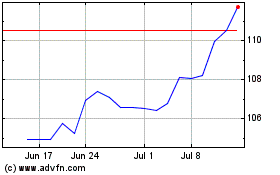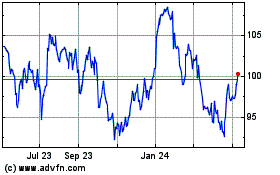By Kristin Broughton
Finance chiefs are selling a new type of bond designed to
attract socially minded investors that costs less and offers more
leeway for companies than other types of sustainable debt.
These instruments, known as sustainability-linked bonds, are
similar to traditional debt sales -- with one major exception: They
are usually structured such that companies pay a higher interest
rate to investors if they fail to achieve a set of environmental
and other goals before the maturity date. Also, the proceeds from
these bonds can be used for general purposes, such as paying down
existing debt, which sets it apart from other types of green,
social and sustainability bonds.
Luxury fashion brand Chanel, pharmaceutical company Novartis AG
and Brazilian paper maker Suzano SA all issued
sustainability-linked bonds in September, according to the Climate
Bonds Initiative, a nonprofit that tracks such debt sales. Italian
utility Enel SpA was the first company to issue this type of debt
last fall.
The four companies together raised roughly $8 billion, according
to Climate Bonds Initiative. There haven't been any issuances by an
American company.
This new type of debt is gaining popularity as companies take
advantage of historically low interest rates to shore up cash as
they weather the pandemic. Chief financial officers, whose job it
is to review their company's funding tools on a regular basis, are
increasingly using new types of debt to demonstrate their social
consciousness credentials to investors, and to attract new types of
investors.
Corporate green-bond issuance has increased by about eightfold
over the past five years, to $77.4 billion, according to data
provider Dealogic. In comparison, investment-grade companies issued
$2.3 trillion in traditional bonds through Oct. 1, a 9% increase
compared with the whole year of 2019, Dealogic said.
Generally, proceeds from green bonds must be spent on a
designated ESG project -- such as construction of a
renewable-energy facility -- and companies have to track and report
to investors how they spent the money. Before issuing a green bond,
companies also adopt a formal ESG financing framework, which is
reviewed by an external firm such an ESG ratings agency.
Sustainability-linked bonds appeal to companies that want to
offer ESG bonds with fewer financial restrictions, executives said.
Companies issuing sustainability-linked bonds expect lower staffing
and administrative costs compared with other types of
environmental, social or governance bonds.
More companies, including U.S. firms, are expected to sell these
bonds in the coming months, said Heather Lang, an executive
director of sustainable finance solutions at the ESG ratings firm
Sustainalytics. That is in part due to new guidelines for this type
of issuance by the International Capital Market Association, an
industry organization, a move that provided additional credibility
to companies issuing these bonds.
Novartis's sustainability-linked bond sale in September totaling
1.85 billion euros -- equivalent to $2.2 billion--was the company's
first trip into the ESG-bond market. The company set itself targets
for increasing patients' access to treatment for malaria and other
illnesses in certain countries by 2025. If an external verifier
determines that Novartis failed to meet those targets by the 2025
deadline, then the coupon rate on the bonds, which is set at zero,
will increase to 0.25% for the following three annual coupon
payments until the bond matures in September 2028, a spokesman
said.
Investors are able to get more clarity on Novartis's social
commitments through such a bond sale, and the company doesn't have
to expend extra resources to isolate ESG projects, a company
spokesman said.
"It is...not practical for us to separate out specific ESG
projects from our so-called 'regular' business activities," the
spokesman said. "And if we could identify and monitor a discrete
project, it wouldn't be of a size to justify a multibillion-dollar
bond issuance in the capital markets."
Novartis said it plans to use the proceeds of the bond offering
for general purposes, and didn't provide any more details. The last
time it issued in euros was two years ago, when it sold bonds with
coupon rates ranging from 0.5% to 1.7%, according to Dealogic.
Enel switched from selling green bonds to sustainability-linked
bonds last fall because of the financial benefits, including lower
administrative costs, said Alberto De Paoli, the company's CFO.
Among those were lower staffing needs, fewer third-party
assessments and less rigid rules on spending the money, Mr. De
Paoli said.
Enel in September 2019 issued a five-year $1.5 billion
sustainability-linked bond carrying a coupon rate of 2.65%, and a
month later sold another 2.5 billion euros, equivalent to $2.9
billion, through the same type of debt offering. The proceeds are
being used to fund sustainability efforts such as network
digitization and renewable-energy projects, a spokeswoman said. As
part of the offerings, Enel pledged to generate 55% of its
installed energy capacity with renewable sources by the end of 2021
and cut its greenhouse-gas emissions. Its interest rates will go up
by 25 basis points annually if it doesn't meet its goals.
Mr. De Paoli said that the financial benefits of
sustainability-linked bonds could push more companies to issue the
debt -- and set targets for improving the environment. "Not because
they want to be sustainable and want to go to heaven, but because
they are pursuing some economical reason," he said.
Write to Kristin Broughton at Kristin.Broughton@wsj.com
(END) Dow Jones Newswires
October 05, 2020 05:44 ET (09:44 GMT)
Copyright (c) 2020 Dow Jones & Company, Inc.
Novartis (NYSE:NVS)
Historical Stock Chart
From Mar 2024 to Apr 2024

Novartis (NYSE:NVS)
Historical Stock Chart
From Apr 2023 to Apr 2024
